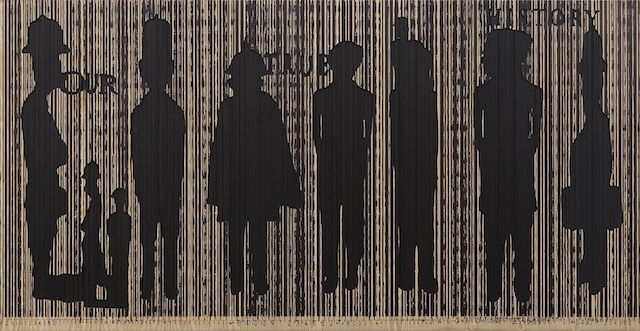This exhibition, its title a play on words by the Cameroonian artist Pascale Marthine Tayou, celebrates the fluidity of ideas and languages across geographic boundaries while referencing both historic and enduring racial divides. Adapted from a term used by abolitionist Frederick Douglass and popularised by the writer and civil rights activist W.E.B. Du Bois to describe racial segregation following the Civil War (‘The problem of the twentieth century is the problem of the color-line, – the relation of the darker to the lighter races of men in Asia and Africa, in America and the islands of the sea’, the latter wrote in 1903), here it headlines a comprehensive, 40-piece survey that pays homage to cultural hybridity and a world in flux.
A familiar face on the international biennial and art-fair circuit, Tayou is nonetheless relatively unknown in the United States. His last New York showing took place nearly 15 years ago, at Lombard Freid Gallery. And while he exhibited in Miami at the Bass Museum in 2017 and at UCLA’s Fowler Museum in 2014, his work is largely unrepresented in the permanent collections of major US institutions.
Tayou’s monumental Code Noir (2018), a seven-panel installation, represents African figures as airport-art carvings silhouetted across what look like giant consumer-packaging barcodes. The Code Noir, passed in 1685 by King Louis XIV of France, outlined, among other points, the laws (which remained in effect until 1848) governing slavery in the French colonies. Tayou’s title also makes reference to the Black Codes, or laws passed by southern US states following the abolition of slavery. Under these codes, blacks were prevented from owning property, leasing land, conducting business or moving freely in public places. Tayou’s panels, each more than two metres in width, point to the lasting impact of the transatlantic slave trade, its legacy of racial inequality and the ongoing relevance of the ‘color line’ to this day.
Cultural clashes and hybrids define all of Tayou’s works. His Bogo Bear (2018), a giant teddy bear, is dressed in Bogolan textiles traditionally worn as camouflage and for protection by male hunters in Mali, as well as by young women following excision rituals and childbirth. The cloth, imbued with energy and power, is used following initiation into adulthood while the stuffed bear is a symbol that is typically associated with a European or American childhood. Tayou’s amalgam emphasises the adaptability of established codes while focusing on the importance of childhood and coming-of-age rituals, and the commonality of human experience.
Included in this presentation are Tayou’s playful Graffiti Neon (2018) and Series ‘Love Letters’ (2015), where amorous and graphic scenes that look hastily drawn in neon, a medium typically reserved for commercial signage, are juxtaposed with similar, more poetic images of paired couples created using traditional materials like straw, nails, charcoal powder and Bogolan textiles. Also on view is a selection of six Poupées Pascale (2010–15) – European hand-blown crystal in the form of tribal statues, embellished with beads, feathers, grass and plastic fruits and vegetables, creating opulent and dissonant textures that merge European and African artmaking traditions.
The idea of the ‘other’ and of the ‘exotic’ cuts both ways in Tayou’s works. Photographs of African children wearing superhero and cartoon masks in Kids Masquerade (2009) is a satirical take on the West’s cultural appropriation of African art. The fusion of visual forms that straddle geographic and cultural borders is not a new phenomenon. Yet as the US Trump administration seeks to reinforce the southern border wall and to implement travel bans from seven predominantly Muslim countries, Tayou’s vision is a timely reminder emphasising the humanist aspect of migration, the natural porosity of boundaries and the reciprocal benefits of transgression.
Pascale Marthine Tayou: Colorful Line at Richard Taittinger Gallery, New York, 2 May – 22 August
From the September 2018 issue of ArtReview
